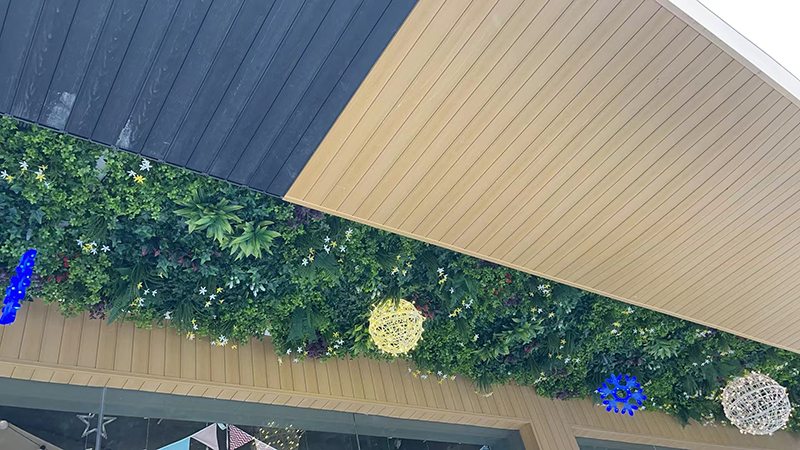Industry Standards for 3D Artificial Vertical Gardens: A Detailed Exploration
The rising adoption of 3D artificial vertical gardens in urban spaces has prompted the development of industry standards to ensure safety, sustainability, and performance. These guidelines, established by international organizations, government agencies, and industry groups, address critical aspects such as material durability, installation protocols, and environmental impact. Understanding these standards is essential for architects, developers, and policymakers aiming to integrate vertical gardens into sustainable urban infrastructure.

Material Safety and Environmental Compliance
One of the primary focuses of industry standards is the selection of materials used in 3D artificial vertical gardens. Guidelines emphasize the use of non-toxic, fire-resistant, and UV-stabilized components to ensure long-term durability and safety. For instance, standards may require that synthetic foliage be made from recycled plastics or biodegradable materials to minimize environmental harm. Additionally, adhesives and coatings used in assembly must comply with regulations limiting volatile organic compound (VOC) emissions, ensuring indoor air quality remains unaffected.
Environmental compliance extends to the lifecycle of vertical garden systems. Standards often mandate that manufacturers provide documentation on the recyclability or disposability of materials at the end of their useful life. Some regions require vertical gardens to incorporate water-efficient irrigation systems, such as drip or capillary action designs, to reduce water consumption. These measures align with broader sustainability goals, encouraging the use of vertical gardens in drought-prone areas without exacerbating resource strain.
Certification programs play a crucial role in verifying material safety and environmental compliance. Third-party organizations may evaluate vertical garden systems against established criteria, awarding certifications that indicate adherence to industry best practices. These certifications can influence purchasing decisions, particularly for public projects where transparency and accountability are prioritized.
Structural Integrity and Installation Protocols
Ensuring the structural stability of 3D artificial vertical gardens is another key area addressed by standards. Guidelines specify load-bearing requirements based on the size and weight of the system, accounting for factors such as wind resistance and seismic activity in earthquake-prone regions. For example, standards may require that vertical gardens mounted on building facades undergo wind tunnel testing to validate their performance under extreme conditions.
Installation protocols are equally important, with standards outlining step-by-step procedures for securing vertical gardens to various substrates, including concrete, steel, and wood. These guidelines emphasize the importance of using corrosion-resistant fasteners and anchors to prevent system failure over time. In some cases, standards may require on-site inspections by certified professionals to verify that installations meet safety and performance benchmarks.
Maintenance requirements are also integrated into structural standards. Regular inspections for signs of wear, such as cracking or discoloration, are recommended to address issues before they compromise safety. Standards may provide schedules for cleaning and replacing components, ensuring that vertical gardens remain visually appealing and functional throughout their lifespan.
Performance Metrics and Aesthetic Guidelines
Defining performance metrics for 3D artificial vertical gardens helps stakeholders evaluate their effectiveness in achieving intended goals, such as improving air quality or reducing noise pollution. Standards may specify minimum thresholds for parameters like particulate matter capture or sound absorption, providing a basis for comparing different systems. These metrics are particularly relevant for projects seeking green building certifications, such as LEED or WELL, which recognize vertical gardens as a credit-earning feature.
Aesthetic guidelines address the visual appeal of vertical gardens, ensuring they complement surrounding architecture and urban landscapes. Standards may recommend color palettes, plant densities, and layout patterns that enhance the overall design without appearing artificial or out of place. For public installations, guidelines often encourage the use of native or culturally significant plant species to foster a sense of community identity and connection to local ecosystems.
Lighting standards are another consideration, particularly for vertical gardens installed in low-light environments or at night. Guidelines may specify the type and intensity of lighting required to maintain plant vibrancy while minimizing light pollution. Some standards also address the integration of smart lighting systems that adjust brightness based on natural light levels, optimizing energy use and visual impact.
Global Harmonization and Local Adaptations
While international standards provide a foundation for consistency, regional adaptations are often necessary to address local climate, cultural, and regulatory differences. For example, standards developed for temperate regions may need modification to suit tropical or arid environments, where humidity and temperature extremes pose unique challenges. Similarly, cultural preferences for plant species or design aesthetics may influence how standards are interpreted and applied in different countries.
Collaboration between global standardization bodies and local authorities is essential to ensure that guidelines remain relevant and effective. Regular updates to standards reflect advancements in technology, such as the development of self-cleaning foliage or modular installation systems, ensuring that vertical gardens continue to meet evolving industry needs.
Conclusion: The Role of Standards in Shaping the Future of Vertical Gardens
Industry standards for 3D artificial vertical gardens play a pivotal role in promoting safety, sustainability, and performance across diverse applications. By addressing material safety, structural integrity, performance metrics, and aesthetic considerations, these guidelines provide a roadmap for stakeholders to create vertical gardens that are both functional and visually appealing. As urbanization accelerates, the continued evolution of standards will be critical in supporting the widespread adoption of vertical gardens as a transformative tool for sustainable urban development.
Contact: Amy
Phone: 86-15311787313
E-mail: info@foszmac.com
Whatsapp:86-15311787313
Add: Fengtai District, Dacheng Road, No.24 Building, Room 203, Beijing, China